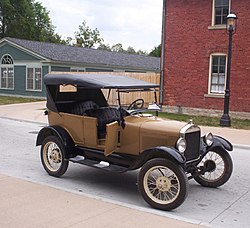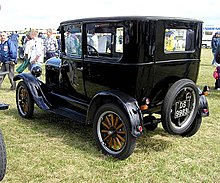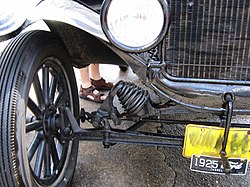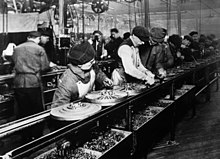Ford Model T
| Ford Model T | |
|---|---|
 | |
| Overview | |
| Manufacturer | Ford Motor Company |
| Production | 1908-1927 |
| Designer | Henry Ford, Childe Harold Wills, Joseph A. Galamb and Eugene Farkas |
| Body and chassis | |
| Class | Full-size Ford, Economy car, SUV |
| Body style | Touring, roadster, roadster pickup, ton truck, closed cab ton truck, coupé, two door, fordor, center door, station wagon (SUV), convertible |
| Powertrain | |
| Engine | 177 in³ (2.9 L) straight-4, 20 hp |
| Transmission | Rear wheel drive, planetary gear, 2 forward speeds |
| Dimensions | |
| Curb weight | 1,200 pounds (540 kg) |
| Chronology | |
| Predecessor | Ford Model S |
| Successor | Ford Model A |


The Ford Model T (colloquially known as the Tin Lizzie and also the Flivver) was an automobile produced by Henry Ford's Ford Motor Company from 1908 through 1927. The Model T set 1908 as the historic year that the automobile came into popular usage. It is generally regarded as the first affordable automobile, the car that "put America on wheels"; some of this was because of Ford's innovations, including assembly line production instead of individual hand crafting, as well as the concept of paying the workers a wage proportionate to the cost of the car, so that they would provide a ready made market.[1] The first production Model T was built on September 27, 1908, at the Piquette Plant in Detroit, Michigan.
There were several cars produced or prototyped by Henry Ford from the founding of the company in 1903 until the Model T came along. Although he started with the Model A, there were not 19 production models (A through T); some were only prototypes. The production model immediately before the Model T was the Ford Model S [2], an upgraded version of the company's largest success to that point, the Model N. The follow-up was the Ford Model A and not the Model U. Company publicity said this was because the new car was such a departure from the old that Henry wanted to start all over again with the letter A. As it happens, the first Plymouth car (1928), built by competitor Chrysler Corporation, was named the Model U.
The Ford Model T was named the world's most influential car of the twentieth century in an international poll. [3] Henry Ford said of the vehicle:
I will build a car for the great multitude. It will be large enough for the family, but small enough for the individual to run and care for. It will be constructed of the best materials, by the best men to be hired, after the simplest designs that modern engineering can devise. But it will be low in price that no man making a good salary will be unable to own one-and enjoy with his family the blessing of hours of pleasure in God's great open spaces.
Characteristics
The Ford Model T car was designed by Childe Harold Wills and two Hungarian immigrants named Joseph A. Galamb and Eugene Farkas[4]. Also, Harry Love, C. J. Smith, Gus Degner and Peter E. Martin were part of the team.[5]. While production of the Model T began in 1908,[6] model years range from 1909 to 1927.
Engine and means of starting
The Model T had a front mounted, 177 in³ (2.9 L) four-cylinder en bloc motor (that is, all four in one block, as common now, rather than in individual castings, as common then) producing 20.2 hp (15 kW) for a top speed of 40-45 mph (64-72 km/h). The small four cylinder engine was known for its L heads. According to Ford Motor, the Model T had fuel economy on the order of 13 to 21 mpg (5 to 9 kilometres per litre or 11.1 to 18.7 litres per 100 km).[7] The engine was capable of running on gasoline or ethanol,[8][9] though the decreasing cost of gasoline and the later introduction of Prohibition in the United States made ethanol an impractical fuel.
A flywheel magneto (broadly equivalent to a modern alternator) produced low voltage alternating current to power a trembler coil, which created a high voltage current. This ignition pulse was passed to the timer (analogous to a distributor in a modern vehicle) and redistributed to the firing cylinder. Ignition timing was adjusted manually by using the spark advance lever mounted on the steering column which rotated the timer. A battery could be used for starting current: at hand-cranking speed, the magneto did not always produce sufficient current. A certain amount of skill and experience was required to find the optimal timing for any speed and load. When electric headlights were introduced in 1915, the magneto was upgraded to supply power for the lights and horn. In keeping with the goal of ultimate reliability and simplicity, the trembler coil and magneto ignition system was retained even after the car became equipped with a generator and battery for electric starting and lighting. Most cars sold after 1919 were equipped with electric starting, which was engaged by a small round pedal on the floor in front of the driver's seat.
Before starting a Model T with the hand crank, the spark had to be manually retarded or the engine might "kick back". The crank handle was cupped in the palm, rather than grabbed with the thumb over the top of the handle, so that if the engine did kick back, the rapid reverse motion of the crank would throw the hand away from the handle, rather than violently twisting the wrist or breaking the thumb. Most Model T Fords had the choke operated by a wire emerging from the bottom of the radiator where it could be operated with the left hand while cranking the engine with the right hand.
The car's 10 gallon (38 litre) fuel tank was mounted to the frame beneath the front seat; one variant had the carburetor (a Holley Model G) modified to run on ethyl alcohol, to be made at home by the self-reliant farmer. Because fuel relied on gravity to flow forward from the fuel tank to the carburetor, a Model T could not climb a steep hill when the fuel level was low. The immediate solution was often to drive up steep hills in reverse. In 1926, the fuel tank was moved forward to under the cowl on most models.[10]
Early on the engine blocks were to be produced by the Lakeside Foundry on St. Jean in Detroit. Ford cancelled the deal before many engine blocks were produced.
While the first few hundred Model Ts had a water pump, its use was abandoned early in production. Ford opted for a cheaper and more reliable circulation system based on the thermo-syphon principle. Hot water, being less dense, would rise to the top of the engine and up into the top of the radiator, descending to the bottom as it cooled, and back into the engine. This was the direction of water flow in most makes of cars even when they did have water pumps, until the introduction of crossflow radiator designs. Water pumps were also available as an aftermarket accessory for Model T.

Transmission and drivetrain
The Model T was a rear-wheel drive vehicle. Its transmission was a planetary gear type billed as "three speed". By today's standards it would be considered a two speed, since one of the three speeds was actually reverse.
The Model T's transmission was controlled with three foot pedals and a lever that was mounted to the road side of the driver's seat. The throttle was controlled with a lever on the steering wheel. The left pedal was used to engage the gear. When pressed and held forward the car entered low gear. When held in an intermediate position the car was in neutral, a state that could also be achieved by pulling the floor-mounted lever to an upright position. If the lever was pushed forward and the driver took his foot off the left pedal, the Model T entered high gear. The car could thus cruise without the driver having to press any of the pedals. There was no separate clutch pedal.
The middle pedal was used to engage reverse gear, and the right pedal operated the engine brake. The floor lever also controlled the parking brake, which was activated by pulling the lever all the way back. This doubled as an emergency brake.
Although it was extremely uncommon, the drive bands could fall out of adjustment, allowing the car to creep, particularly when cold, adding another hazard to attempting to start the car: a person cranking the engine could be forced backward while still holding the crank as the car crept forward even though it was nominally in neutral. Power reached the differential through a single universal joint attached to a torque tube which drove the rear axle; some models (typically trucks) could be equipped with an optional two speed rear axle shifted by a floor mounted lever. All gears were vanadium steel running in an oil bath.

Suspension and wheels
Model T suspension employed a transversely mounted semi-elliptical spring for each of the front and rear axles, which were "live", i.e., not an independent suspension.
The front axle was drop forged as a single piece of vanadium steel. Ford twisted many axles eight times and sent them to dealers to be put on display to demonstrate its superiority. The Model T did not have a modern service brake. The right foot pedal applied a band around a drum in the transmission, thus stopping the rear wheels from turning. The previously mentioned parking brake lever operated band brakes on the outside of the rear brake drums.
Wheels were wooden artillery wheels, with steel welded-spoke (not truly wire) wheels available in 1926 and 1927.
Tires were pneumatic 30 in (76 cm) in diameter, 3.5 in (8.9 cm) wide in the rear, 2 in (5 cm) in the front. The old nomenclature for tire size changed from 30×3 to 21" (rim diameter) × 4.50 (tire width).[clarification needed]
Wheelbase was 99 inches; while standard tread width was 56 in (142 cm), 60 in (152 cm) tread could be obtained on special order, "for Southern roads".
Design changes
There were few major changes throughout the life of this model; early ones had a brass radiator and headlights. The horn and numerous small parts were also brass. Many of the early cars were open-bodied touring cars and runabouts, these being cheaper to make than closed cars. Prior to the 1911 model year (when front doors were added to the touring model), U.S.-made open cars did not have an opening door for the driver. Later models included closed cars (introduced in 1915),[11] sedans, coupes and trucks. The chassis was available so trucks could be built to suit. Ford also developed some truck bodies for this chassis, designated the Model TT. The headlights were originally acetylene lamps made of brass (commonly using Prest-O-Lite tanks),[12] but eventually the car gained electric lights.
The Model T originally employed some advanced technology, for example, its use of vanadium steel. Its durability was phenomenal with many Model Ts and their parts still in use 80 years later.
Colors
Henry Ford is commonly reputed to have made the statement "Any customer can have a car painted any color that he wants so long as it is black." Actually, Model Ts in different colors were produced from 1908 to 1914, and then again from 1926 to 1927. It is often stated that Ford chose black because the paint dried faster than other colored paints available at the time, and a faster drying paint would allow him to build cars faster since he would not have to wait for the paint to dry.
Over 30 different types of black paint were used to paint various parts of the Model T.[citation needed] The different types of paint were formulated to satisfy the different means of applying the paint to the different parts, and they had different drying times, depending on the paint and the drying method used for a particular part. Ford engineering documents suggest that the color black was chosen because it was cheap and it was durable.
Production
Mass production


The Model T was the first automobile mass produced on assembly lines with completely interchangeable parts, marketed to the middle class.
When introduced, the T used the building methods typical at the time, assembly by hand, and production was small. Ford's Piquette plant could not keep up with demand for the Model T, and only 11 cars were built there during the first full month of production. In 1910, after assembling nearly 12,000 Model Ts, Henry Ford moved the company to the new Highland Park complex.
The assembly line was introduced to Ford by William C. Klann upon his return from visiting a slaughterhouse at Chicago's Union Stock Yards and viewing what was referred to as the "disassembly line" where animals were cut apart as they moved along a conveyor. The efficiency of one person removing the same piece over and over caught his attention. He reported the idea to Peter E. Martin, who was doubtful at the time, but encouraged him to proceed. Others at Ford have claimed to have put the idea forth to Henry Ford, but William "Pa" Klann's slaughterhouse revelation is well documented in the archives at the Henry Ford Museum and elsewhere, making him the father of the modern automated assembly line concept. The process was an evolution by trial and error of a team consisting primarily of Peter E. Martin, the factory superintendent; Charles E. Sorensen, Martin's assistant; Harold Wills, draftsman and toolmaker; Clarence W. Avery; and Charles Lewis.[13][14][15] When the first car was completed using the assembly line, in front of the media, onlookers and even Henry Ford, it was Pa Klann who drove it proudly off the line.
As a result, Ford's cars came off the line in three minute intervals, much faster than previous methods, increasing production by eight to one (requiring 12.5 man-hours before, 1 hour 33 minutes after), while using less manpower.[16]
By 1914, the assembly process for the Model T had been so streamlined it took only 93 minutes to assemble a car. That year Ford produced more cars than all other automakers combined. The Model T was a great commercial success, and by the time Henry made his 10 millionth car, 9 out of 10 of all cars in the entire world were Fords. In fact, it was so successful that Ford did not purchase any advertising between 1917 and 1923; in total, more than 15 million Model Ts were manufactured, more than any other model of automobile for almost a century.
Henry Ford's eccentric approach to research and development meant few changes to the vehicle were made over its lifetime; he believed the Model T was all the car a person would, or could, ever need. As other companies offered comfort and styling advantages, at competitive prices, the Model T lost market share. Eventually, on May 26, 1927, Ford Motor Company ceased production and began the changeovers required to produce the Model A.[17]
Model T engines continued to be produced until August 4, 1941. Almost 170,000 engines were built after car production stopped. Replacement engines were required to continue to service already produced vehicles. Racers and enthusiasts, forerunners of modern hot rodders, used the Model T's block to build popular and cheap racing engines, including Cragar, Navarro, and famously the Frontenacs ("Fronty Fords") of the Chevrolet brothers, among many others.
Price
The standard four-seat open tourer of 1909 cost US$850 (about ₤180 at the time),[18] when competing cars often cost $2000-$3000;[citation needed] in 1913, the price dropped to $550, and $440 in 1915. Sales were 69,762 in 1911, 170,211 in 1912, 202,667 in 1913, 308,162 in 1914, and 501,462 in 1915.[19] In 1914, an assembly line worker could buy a Model T with four months' pay.[20]
By the 1920s, the price had fallen to $300 (about $3,400 in 2006 inflation-adjusted dollars) because of increasing efficiencies of assembly line technique and volume. Henry employed vertical integration of the industries needed to create his cars. He specified how to make the wood crates that outside suppliers used to ship him parts. Then he disassembled the crates and used the preformed wood pieces in the bodies of his cars. He also used wood scraps to make charcoal and sold it under the brand name "Kingsford," still a leading brand of charcoal.
First world car
The Ford Model T was the first automobile built by various countries simultaneously. First built abroad by Ford of Britain in 1914, they were also assembled by Ford Germany and in various South American countries, including Argentina and Brazil.
Advertising, marketing, and packaging
Ford created a massive publicity machine in Detroit to ensure every newspaper carried stories and ads about the new product. Ford's network of local dealers made the car ubiquitous in virtually every city in North America. As independent dealers, the franchises grew rich and publicized not just the Ford but the very concept of automobiling; local motor clubs sprang up to help new drivers and to explore the countryside. Ford was always eager to sell to farmers, who looked on the vehicle as a commercial device to help their business. Sales skyrocketed—several years posted 100% gains on the previous year. Always on the hunt for more efficiency and lower costs, in 1913 Ford introduced the moving assembly belts into his plants, which enabled an enormous increase in production. Although Henry Ford is often credited with the idea, contemporary sources indicate that the concept and its development came from employees Clarence Avery, Peter E. Martin, Charles E. Sorensen, and C. Harold Wills. (See Piquette Plant)

Sales passed 250,000 in 1914. By 1916, as the price dropped to $360 for the basic touring car, sales reached 472,000.[21]
By 1918, half of all cars in America were Model T's. However, it was a monolithic block; as Ford wrote in his autobiography, "Any customer can have a car painted any colour that he wants so long as it is black".[22] Until the development of the assembly line, which mandated black because of its quicker drying time, Model T's were available in other colors including red. The design was fervently promoted and defended by Ford, and production continued as late as 1927; the final total production was 15,007,034. This record stood for the next 45 years.
This record was achieved in just 19 years flat from the introduction of the first Model T (1908).
Summary
Ford was launched in a converted factory in 1903 with $28,000 in cash from twelve investors, most notably John and Horace Dodge (who would later found the their own car company). During its early years, the company produced just a few cars a day at its factory on Mack Avenue in Detroit, Michigan. Groups of two or three men worked on each car from components made to order by other companies. Henry Ford was 40 years old when he founded the Ford Motor Company, which would go on to become one of the world's largest and most profitable companies, as well as being one to survive the Great Depression. As one of the largest family-controlled companies in the world, the Ford Motor Company has been in continuous family control for over 100 years.
Car clubs
Cars built before 1919 are classed as veteran cars and later models as vintage cars. Today, two main clubs exist to support the preservation and restoration of these cars: The Model T Ford Club International and the Model T Ford Club of America. Many steel Model T parts are still manufactured today, and even fiberglass replicas of their distinctive bodies, which are popular for T-bucket style hot rods (as immortalized in the Jan and Dean surf music song "Bucket T," which was later recorded by The Who).

The Model T in popular culture
- The Model T featured prominently in many Laurel and Hardy movies.
- In the 2006 film, Cars, one of the Radiator Springs residents is a Model T named Lizzie.
- In the two part Speed Racer episode "The Secret Engine" the Model T is the focus of the episode.
- The film The Absent-Minded Professor, a Model T plays a key role in the story
- The 1949 Broadway musical "High Button Shoes" features a song called "There's Nothing Like a Model T" (music by Jule Styne, Lyrics by Sammy Cahn).
- The antique car ride at Lakemont Park resembling the Ford Model T, is named Tin Lizzy.
Criticism
In a Time Magazine article by automotive critic Dan Neil, the Model T is listed as one of the 50 worst cars of all time. Neil blames the consequences of mass-produced automobiles on the Model T, including heavy pollution and war in the Middle East. Specific criticisms for the Model T itself are "blacksmithed body panels and crude instruments" and Neil refers to it as, "The Yugo of its day." [23]
Image gallery
-
Ford Model T - 1914
See also
- Ford Model T engine
- Henry Ford
- Ford Motor Company
- Aeroford - a British copy on the Model T
Notes
- ^ Ford also attempted a buy on time program to aid sales, resembling that of the German Kdf-Wagen [the forerunner of the Volkswagen Beetle]. Ford's plan was not a success, either.
- ^ Early Ford - models from the years 1903 - 1908; page 5
- ^ Joyrides | Car of the Century? Ford's Model T, of course
- ^ "History Lesson: Hungary Celebrates the Ford Model T". Edmunds.com. Retrieved 2008-02-29.
{{cite web}}: Italic or bold markup not allowed in:|publisher=(help) - ^ Reynold M. Wik, Henry Ford Grass Roots America, 1972
- ^ Clymer, Floyd. Treasury of Early American Automobiles, 1877-1925 (New York: Bonanza Books, 1950), p.100.
- ^ media.ford.com Model T Facts
- ^ "Ford Model T reaches 100". The Telegraph. 2008-07-25. Retrieved 2008-08-11.
- ^ "Ethanol: Introduction". Journey to Forever. Retrieved 2008-08-11.
- ^ 1926 - Model T Ford Club of America
- ^ Clymer, p.37.
- ^ Clymer, p.100.
- ^ First hand account of Charles Sorensen from his autobiography, My Forty Years with Ford (1956)[1]
- ^ Essay by Stephen C. Perry, Gardner-Webb University (Published May 8, 2000)
- ^ Douglas Brinkley, Wheels for the World, 2003
- ^ Georgano.
- ^ detnews.com | Michigan History
- ^ Ward, Ian, ed. The World of Automobiles (London: Orbis, 1974), Volume 13, p.1562.
- ^ Georgano, G. N. Cars: Early and Vintage, 1886-1930. (London: Grange-Universal, 1985)
- ^ Georgano.
- ^ Lewis 1976, pp 41–59
- ^ Ford, My Life and Work, 1922, p. 72.
- ^ "The 50 Worst Cars of All Time". TIME.com. Retrieved 2008-06-23.
{{cite web}}: Italic or bold markup not allowed in:|publisher=(help)
References
- Model T Facts, retrieved 2007-02-19
- Identification Chart for Model T Body Styles (page 107), retrieved 2008-04-08










